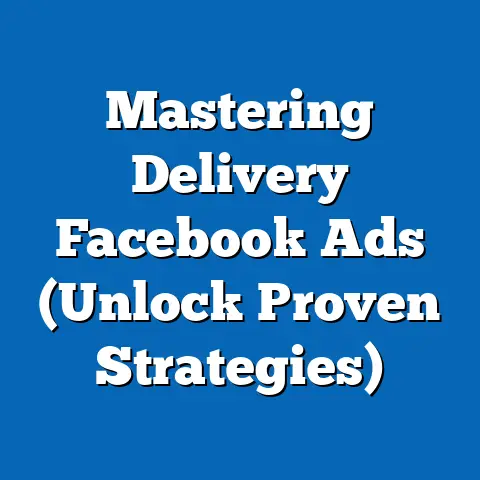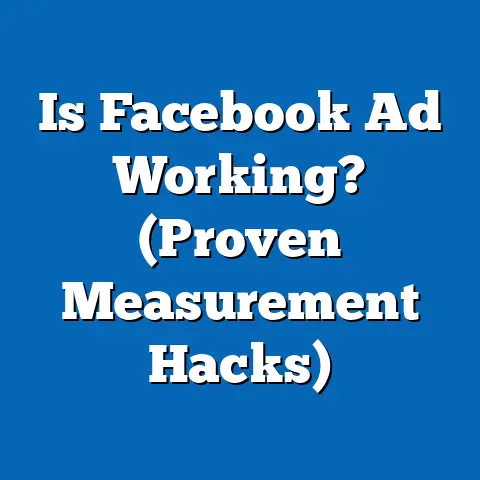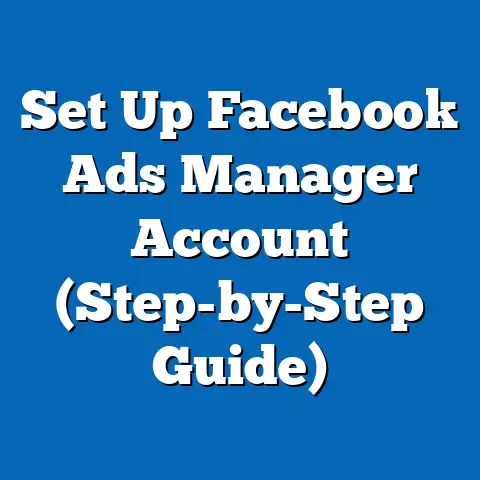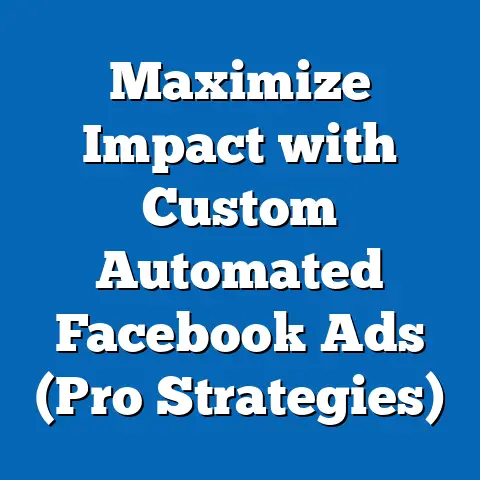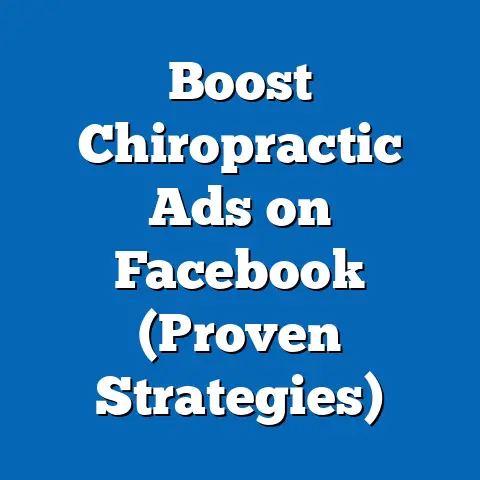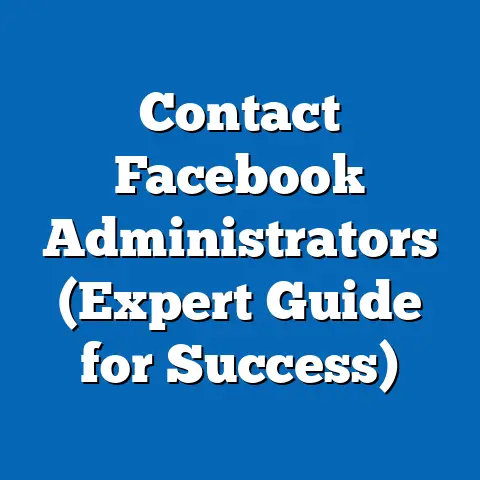Revamp Restaurant’s Facebook Ads Strategy (Expert Tips)
I’ve been in the digital marketing game for quite a while, and one thing I’ve consistently seen is the power of Facebook ads to transform businesses, especially in the restaurant industry. It’s not just about throwing up a quick ad and hoping for the best. It’s about understanding the platform, your audience, and crafting a strategy that truly resonates.
The restaurant industry is becoming increasingly competitive, and digital advertising has become a crucial battleground. Consumers are constantly bombarded with options, and capturing their attention requires a strategic and well-executed Facebook ads strategy. Studies show that a significant percentage of diners now discover new restaurants through social media, and visual content is incredibly effective in attracting their attention. This isn’t just a trend; it’s the new normal.
In this guide, I’m going to share my expert tips for revamping your restaurant’s Facebook ads strategy. I’ll walk you through everything from understanding the platform to crafting compelling content, setting budgets, and measuring success. Get ready to take your restaurant’s marketing to the next level!
1. Understanding the Facebook Ads Landscape
Facebook Ads is a powerful advertising platform that allows businesses to reach a vast audience with targeted messaging. At its core, Facebook Ads operates on an auction system. Advertisers bid against each other to show their ads to specific users. The winning bid, combined with the ad’s quality and relevance, determines which ads are displayed.
The beauty of Facebook Ads lies in its detailed targeting options. You can target users based on demographics (age, gender, location), interests (food, dining, cuisine types), behaviors (frequent travelers, online shoppers), and even custom audiences (people who have visited your website or are on your email list).
Facebook offers a variety of ad formats to suit different marketing goals:
- Image Ads: Simple and effective for showcasing a single, high-quality image of your food or restaurant.
- Video Ads: Ideal for telling a story, showcasing your restaurant’s atmosphere, or featuring customer testimonials.
- Carousel Ads: Allow you to display multiple images or videos in a single ad, perfect for showcasing different menu items or highlighting various aspects of your restaurant.
- Collection Ads: Designed for mobile users, these ads feature a cover image or video followed by a collection of products or items.
- Lead Ads: Capture leads directly within the Facebook platform, making it easy for potential customers to express interest in your restaurant.
Why Facebook Ads for Restaurants?
For restaurants, Facebook advertising offers several unique advantages:
- Local Targeting: Reach potential customers in your immediate vicinity, ensuring that your ads are seen by people who can actually visit your restaurant. I’ve personally used geo-targeting to hyper-target neighborhoods around a client’s restaurant, and the results were phenomenal.
- Engaging Visual Content: Showcase your delicious food with high-quality images and videos, enticing potential customers to dine with you.
- Measurable Results: Track the performance of your ads in real-time, allowing you to optimize your campaigns and maximize your ROI.
- Cost-Effective Advertising: Compared to traditional advertising methods, Facebook Ads can be a more affordable way to reach a large audience.
- Direct Engagement: Interact with potential customers directly through comments, messages, and reviews, building relationships and fostering loyalty.
Takeaway: Understanding the fundamentals of Facebook Ads is crucial for creating a successful advertising strategy for your restaurant. Familiarize yourself with the auction system, targeting options, and ad formats to make informed decisions.
2. Defining Your Target Audience
One of the biggest mistakes I see restaurants make with their Facebook ads is failing to define their target audience properly. It’s tempting to try and reach everyone, but this approach is rarely effective. Instead, you need to identify the specific groups of people who are most likely to become your customers.
Audience Segmentation: The Key to Success
Audience segmentation involves dividing your potential customers into smaller groups based on shared characteristics. This allows you to create more targeted and relevant ads that resonate with each group. Here’s how to approach audience segmentation for your restaurant:
- Demographics: Consider factors like age, gender, income, education, and location. For example, if you’re a high-end restaurant, you might target affluent individuals in your local area.
- Interests: Identify the interests of your target audience. Are they foodies? Do they enjoy fine dining? Are they interested in specific cuisines? You can target users based on their expressed interests on Facebook. I once ran a campaign for a vegan restaurant targeting users interested in veganism, vegetarianism, and animal rights, and it performed exceptionally well.
- Behaviors: Consider the behaviors of your target audience. Are they frequent diners? Do they order takeout regularly? Do they attend local events? You can target users based on their online and offline behaviors.
- Custom Audiences: Create custom audiences based on your existing customer data. Upload your email list or phone numbers to Facebook to target your current customers with special offers or promotions. You can also create lookalike audiences, which are audiences that share similar characteristics with your existing customers.
Creating Customer Personas
Customer personas are fictional representations of your ideal customers. They help you understand your target audience on a deeper level and create more relevant and engaging ads. Here’s an example of a customer persona for a hypothetical Italian restaurant:
- Name: Sarah Miller
- Age: 35
- Occupation: Marketing Manager
- Income: $75,000/year
- Location: Chicago, IL
- Interests: Italian food, wine, travel, cooking
- Behaviors: Dines out 2-3 times per week, orders takeout occasionally, attends local food festivals
- Goals: Enjoys trying new restaurants, looking for a romantic dinner spot, wants to impress her clients with a great meal
By creating customer personas like Sarah, you can better understand the needs and motivations of your target audience and craft ads that resonate with them.
Utilizing Facebook’s Audience Insights Tool
Facebook’s Audience Insights tool provides valuable data about your target audience, including demographics, interests, behaviors, and more. This tool can help you refine your targeting efforts and create more effective ad campaigns.
To access Audience Insights, go to your Facebook Ads Manager and select “Audience Insights” from the menu. You can then select your target audience (either everyone on Facebook or people connected to your Page) and explore the various data points available.
Takeaway: Defining your target audience is essential for creating successful Facebook ad campaigns for your restaurant. Use audience segmentation, create customer personas, and utilize Facebook’s Audience Insights tool to refine your targeting efforts.
3. Crafting Compelling Ad Content
Once you’ve defined your target audience, the next step is to create compelling ad content that captures their attention and motivates them to take action. This involves crafting high-quality visuals and engaging copy that resonate with your audience.
The Power of Visuals
In the restaurant industry, visuals are everything. People eat with their eyes, so it’s crucial to showcase your food in the most appealing way possible.
- High-Quality Photography: Invest in professional food photography that highlights the freshness, flavor, and presentation of your dishes. Avoid using blurry or poorly lit photos.
- Mouth-Watering Images: Focus on capturing images that make people’s mouths water. Use close-up shots to showcase the textures and details of your food.
- Lifestyle Shots: Include lifestyle shots that show people enjoying your food in a social setting. This can help potential customers visualize themselves dining at your restaurant.
- Video Content: Create short, engaging videos that showcase your restaurant’s atmosphere, highlight your menu items, or feature customer testimonials.
Engaging Ad Copy
While visuals are important, compelling ad copy is essential for driving conversions. Your ad copy should be clear, concise, and persuasive, highlighting the unique selling points of your restaurant.
- Use Persuasive Language: Use words that evoke emotion and create a sense of urgency. Words like “delicious,” “authentic,” “fresh,” and “limited-time” can be very effective.
- Clear Call to Action: Tell people exactly what you want them to do. Use clear and concise calls to action like “Order Now,” “Book a Table,” or “Learn More.”
- Emphasize Unique Selling Points: Highlight what makes your restaurant special. Do you use local ingredients? Do you have a unique atmosphere? Do you offer special menus or promotions?
- Keep it Concise: People have short attention spans, so keep your ad copy brief and to the point. Get straight to the benefits of dining at your restaurant.
- Test Different Variations: Experiment with different ad copy variations to see what resonates best with your audience. A/B testing can help you optimize your ad copy for maximum impact.
Examples of Successful Ad Creatives
Here are a few examples of successful ad creatives from restaurants that have effectively captivated their audience:
- Example 1: A high-end steakhouse uses a stunning image of a perfectly grilled steak with the caption: “Indulge in the ultimate steak experience. Book your table now and savor the flavor of perfection.”
- Example 2: A casual Mexican restaurant uses a vibrant image of a plate of tacos with the caption: “Taco Tuesday just got better! Join us for delicious tacos, refreshing margaritas, and good times.”
- Example 3: A vegan restaurant uses a colorful image of a plant-based burger with the caption: “Delicious and sustainable. Try our new vegan burger and experience the future of food.”
Takeaway: Crafting compelling ad content is essential for capturing the attention of your target audience and driving conversions. Invest in high-quality visuals and engaging copy that highlight the unique selling points of your restaurant.
4. Leveraging Facebook Ad Features
Facebook Ads offers a variety of features that can enhance your restaurant marketing strategies. Let’s explore some of the most effective options:
- Carousel Ads: These ads allow you to showcase multiple images or videos in a single ad. This is perfect for highlighting different menu items, showcasing your restaurant’s atmosphere, or featuring customer testimonials. Think of it as a mini-menu that users can scroll through right in their feed. I’ve seen carousel ads work wonders for restaurants with extensive menus, allowing them to showcase a variety of options and cater to different tastes.
- Video Ads: Video ads are incredibly engaging and can be used to tell a story, showcase your restaurant’s atmosphere, or feature customer testimonials. Consider creating a short video that gives potential customers a behind-the-scenes look at your kitchen or features a chef preparing a signature dish.
- Event Promotion Ads: These ads are designed to promote special events or limited-time offers. If you’re hosting a wine tasting, a live music night, or a holiday-themed dinner, use event promotion ads to reach potential attendees.
- Offer Ads: Offer ads allow you to create and promote special offers directly on Facebook. This is a great way to drive traffic to your restaurant and encourage customers to try new dishes or promotions.
- Lead Ads: Lead ads allow you to capture leads directly within the Facebook platform. This is a great way to build your email list and nurture potential customers.
The Importance of Facebook Pixel
The Facebook Pixel is a small piece of code that you can install on your website to track conversions and retarget previous visitors. This is a crucial tool for optimizing your Facebook ad campaigns and maximizing your ROI.
With the Facebook Pixel, you can:
- Track Conversions: See which of your Facebook ads are driving the most conversions (e.g., online orders, reservations, website visits).
- Retarget Previous Visitors: Show ads to people who have previously visited your website but haven’t yet converted. This is a highly effective way to bring back potential customers and encourage them to take action.
- Create Lookalike Audiences: Create audiences that share similar characteristics with your website visitors. This can help you expand your reach and target new potential customers.
Takeaway: Leverage Facebook’s various ad features to enhance your restaurant marketing strategies. Use carousel ads to showcase your menu, video ads to tell your story, and event promotion ads to promote special events. Don’t forget to install the Facebook Pixel to track conversions and retarget previous visitors.
5. Budgeting and Bidding Strategies
Setting a budget for your Facebook ad campaigns is a crucial step in ensuring that you’re getting the best possible return on your investment. Here’s how to approach budgeting and bidding strategies for your restaurant:
- Daily vs. Lifetime Budgets: Facebook allows you to set either a daily budget or a lifetime budget for your ad campaigns. A daily budget is the average amount you’re willing to spend each day, while a lifetime budget is the total amount you’re willing to spend over the entire duration of the campaign. I generally recommend starting with a daily budget, as it allows for more flexibility and control.
- Determining Your Budget: How much should you spend on Facebook ads? This depends on a variety of factors, including your marketing goals, your target audience, and your competition. A good starting point is to allocate a percentage of your overall marketing budget to Facebook ads. I’ve seen restaurants allocate anywhere from 5% to 20% of their marketing budget to Facebook, depending on their specific needs and goals.
- Bidding Strategies: Facebook offers several bidding strategies to choose from, including automatic bidding and manual bidding. Automatic bidding allows Facebook to automatically set your bids to get the most results for your budget. Manual bidding gives you more control over your bids, allowing you to set your bids manually. I generally recommend starting with automatic bidding, as it’s a good way to get a feel for the platform and see what kind of results you can achieve. Once you have some data, you can experiment with manual bidding to try and optimize your campaigns further.
- Optimizing for ROAS: Return on Ad Spend (ROAS) is a key metric for measuring the success of your Facebook ad campaigns. It measures the amount of revenue you generate for every dollar you spend on advertising. To optimize for ROAS, you need to track your conversions and revenue and make adjustments to your campaigns based on the data.
Takeaway: Set a realistic budget for your Facebook ad campaigns and choose a bidding strategy that aligns with your marketing goals. Track your ROAS and make adjustments to your campaigns based on the data.
6. Measuring Success and Optimizing Campaigns
Measuring the success of your Facebook ad campaigns is crucial for ensuring that you’re getting the best possible return on your investment. Here are some key performance indicators (KPIs) that restaurants should track:
- Click-Through Rate (CTR): This measures the percentage of people who see your ad and click on it. A high CTR indicates that your ad is relevant and engaging to your target audience.
- Conversion Rate: This measures the percentage of people who click on your ad and then take a desired action, such as placing an order, making a reservation, or visiting your website. A high conversion rate indicates that your ad is effective at driving conversions.
- Cost Per Click (CPC): This measures the average cost you pay for each click on your ad. A low CPC indicates that your ad is cost-effective.
- Cost Per Acquisition (CPA): This measures the average cost you pay for each conversion. A low CPA indicates that your ad is efficient at driving conversions.
- Return on Ad Spend (ROAS): This measures the amount of revenue you generate for every dollar you spend on advertising. A high ROAS indicates that your ad is profitable.
A/B Testing: The Key to Optimization
A/B testing involves testing different variations of your ads to see which ones perform best. This is a crucial step in optimizing your Facebook ad campaigns for maximum impact.
Here are some elements you can A/B test:
- Images: Test different images to see which ones are most appealing to your target audience.
- Ad Copy: Test different ad copy variations to see which ones are most persuasive.
- Audiences: Test different audiences to see which ones are most responsive to your ads.
- Calls to Action: Test different calls to action to see which ones drive the most conversions.
Data-Driven Adjustments
Based on the performance metrics you track, make data-driven adjustments to your campaigns. This might involve changing your targeting, adjusting your budget, or modifying your ad creatives. The key is to continuously monitor your campaigns and make adjustments based on the data. I had a client whose initial ad copy wasn’t performing well. After A/B testing several variations, we discovered that using a more casual and humorous tone resonated much better with their target audience, leading to a significant increase in engagement and conversions.
Takeaway: Measure the success of your Facebook ad campaigns by tracking key performance indicators. Use A/B testing to optimize your ads and make data-driven adjustments to your campaigns based on the results.
7. Case Studies and Success Stories
Let’s take a look at a few case studies of restaurants that have successfully revamped their Facebook ads strategy:
- Case Study 1: A local pizza restaurant was struggling to attract new customers. They revamped their Facebook ads strategy by creating targeted ads that showcased their delicious pizzas and offered special promotions. They also installed the Facebook Pixel to track conversions and retarget previous visitors. As a result, they saw a 30% increase in online orders and a 20% increase in foot traffic.
- Case Study 2: A fine-dining restaurant was looking to increase their brand awareness and attract a more affluent clientele. They revamped their Facebook ads strategy by creating high-quality video ads that showcased their elegant atmosphere and featured customer testimonials. They also targeted affluent individuals in their local area. As a result, they saw a 40% increase in brand awareness and a 25% increase in reservations.
- Case Study 3: A casual Mexican restaurant wanted to promote their Taco Tuesday special. They revamped their Facebook ads strategy by creating vibrant image ads that showcased their delicious tacos and offered a special discount on Tuesdays. They also targeted foodies and people interested in Mexican cuisine. As a result, they saw a 50% increase in Taco Tuesday sales.
These case studies demonstrate the power of a thoughtful and targeted approach to Facebook advertising. By understanding your target audience, crafting compelling content, and leveraging Facebook’s various ad features, you can achieve significant results.
Takeaway: Learn from the success stories of other restaurants and implement a thoughtful and targeted approach to Facebook advertising.
Conclusion: The Future of Facebook Advertising for Restaurants
The future of Facebook advertising for restaurants is bright. As technology continues to evolve, new opportunities will emerge for restaurants to connect with their customers and drive business.
Here are some emerging trends to watch:
- Augmented Reality (AR) in Ads: Imagine being able to virtually “try on” a dish before ordering it. AR technology is becoming increasingly integrated into Facebook ads, allowing restaurants to offer immersive and interactive experiences.
- User-Generated Content: Encourage your customers to share their photos and videos of your restaurant on social media. User-generated content is authentic and trustworthy, and it can be a powerful way to promote your restaurant.
- Personalized Advertising: As Facebook continues to gather more data about its users, it will become easier to deliver personalized ads that are tailored to individual preferences and interests.
- The Growing Importance of Video: Video content is becoming increasingly dominant on social media. Restaurants that embrace video marketing will have a significant advantage.
To stay ahead of the curve, restaurants need to:
- Embrace New Technologies: Be willing to experiment with new technologies like AR and AI to enhance your advertising efforts.
- Focus on Customer Experience: Create a positive customer experience both online and offline. Happy customers are more likely to share their experiences on social media and recommend your restaurant to others.
- Stay Informed: Stay up-to-date on the latest Facebook advertising trends and best practices.
By staying ahead of the curve and adapting to the evolving landscape, restaurants can effectively engage their audience, drive foot traffic, and achieve long-term success with Facebook advertising.
I hope this guide has provided you with valuable insights and actionable tips for revamping your restaurant’s Facebook ads strategy. Remember, it’s not about overnight success. It’s about continuous learning, testing, and optimization. Good luck!

